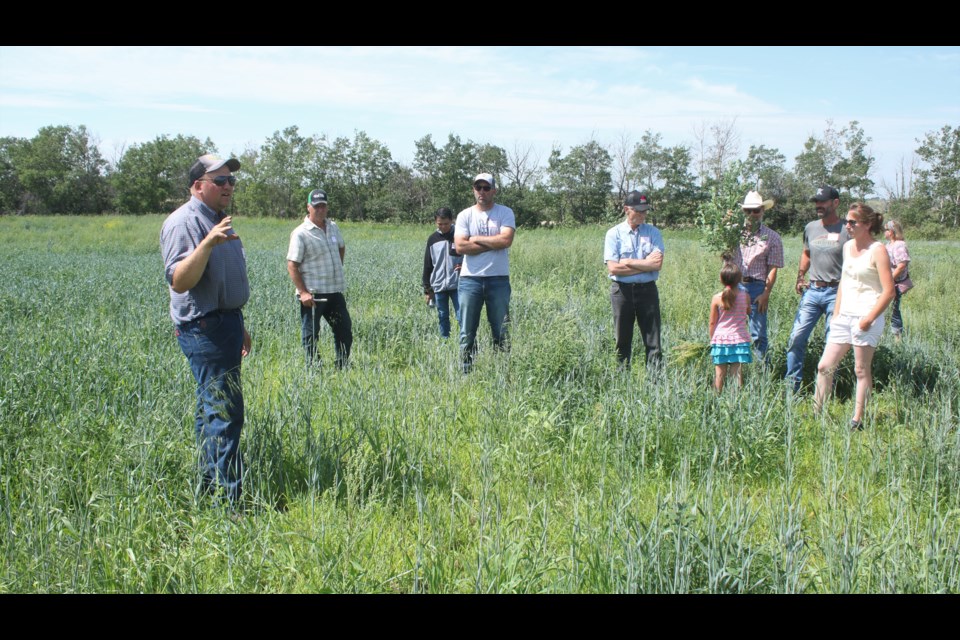Running cattle can help agricultural producers build their soil.
That was the focus of a field day held in the Bangor area this week. The day was arranged by Sask Organics and called ‘Covering Our Tracks’ focusing on the benefits of grazing with, or without owning livestock.
The day started with a visit to the family farm of Keith Buckingham, where those attending had an up-close look at fencing demonstrations, moving of cattle, custom grazing options, and cropping in 2019 on two fields – one of which was cover crops and one of which was summer fallow the year before.
Keith and Emily Buckingham and their two daughters moved from Admiral, SK to south of Yorkton in 2016 and started the transition process the same year.
They utilize livestock and cover crops to build soil health along with intercropping to help control weeds on crop land. The Buckingham’s are of the belief that all land should have grazing livestock to be part of a healthy ecosystem.
As a result Buckingham runs a herd of about 150 cows, and then custom grazes for other producers, meaning much of the land he owns or leases is dedicated to grazing for cattle. He explained he uses a rather intensive grazing system where cattle are allowed access to limited acres, graze it and are then moved to a fresh paddock every two or three days.
Normally an area of pasture is grazed twice a year, although in some cases Buckingham said a third grazing may be possible.
The key is not to get too large an area for the number of cattle in a pasture.
“The larger and narrower (a pasture is) the more they trample moving up and back,” said Buckingham.
Water is also a key consideration.
“You can have all the forage in the world but if you don’t have clean water ... “ said Buckingham.
Buckingham said he’d reduce the paddocks to a half-acre in an ideal world, but added “I don’t have enough time to move them two or three times a day.”
At the same time Buckingham said he has to keep the cattle well-fed so he can’t over graze.
As a custom grazer he noted, “If you’re not doing a good job of keeping them (the cattle) full, they’re not coming back.”
When it comes to pasture Buckingham uses a variety of options, sometimes growing oats which can be grazed, silaged or even harvested depending on the needs of the cattle.
Other times Buckingham plants a diverse forage mixture which can include alfalfa, brome and orchard grass as examples.
With the varied pastures, including native grassland, Buckingham looks to maximize the time the cows spend fending for themselves. This year some cows went to pasture April 23, although they were supplemented by stockpiled green feed and bales initially. The cows were allowed to graze the first day in a paddock taking what there was, and the second day were given additional feed.
“The majority of the cow herd was out in May,” he added.
Last year the cows grazed until mid-January, although again they were supplemented in the latter weeks with some oats for added energy.
“We shoot for 200-days of the year (on pasture), if not more,” said Buckingham.
Buckingham said he also looks to match the cows he owns to the plan for grazing, preferring 1100 to 1200 pound animals.
“My cows know I don’t love them, they have to go out and get something to eat,” he said, adding bigger cows do eat more.
Buckingham noted much of his land is sandy and he has looked to build it through his farm practices.
“Cover crops and grazing can build soil quite fast,” he said.
Some of the cash crops they grow are oats, peas, barley, lentils, and flax.
In terms of cash crops Buckingham devotes about 500-acres annually, often inter-crops his fields. This year he has a field where lentils and flax are being grown together. He planted 30 pounds of flax per acre, with 60 pounds of lentils.
The crop will be harvested, and then separate the two crops for sale.
The companion cropping is a way to diversify the types of plants in a field which is good for soil health, and in terms of weed competition.
Buckingham said growing two species together “is huge for keeping fields clean (less weeds).”

